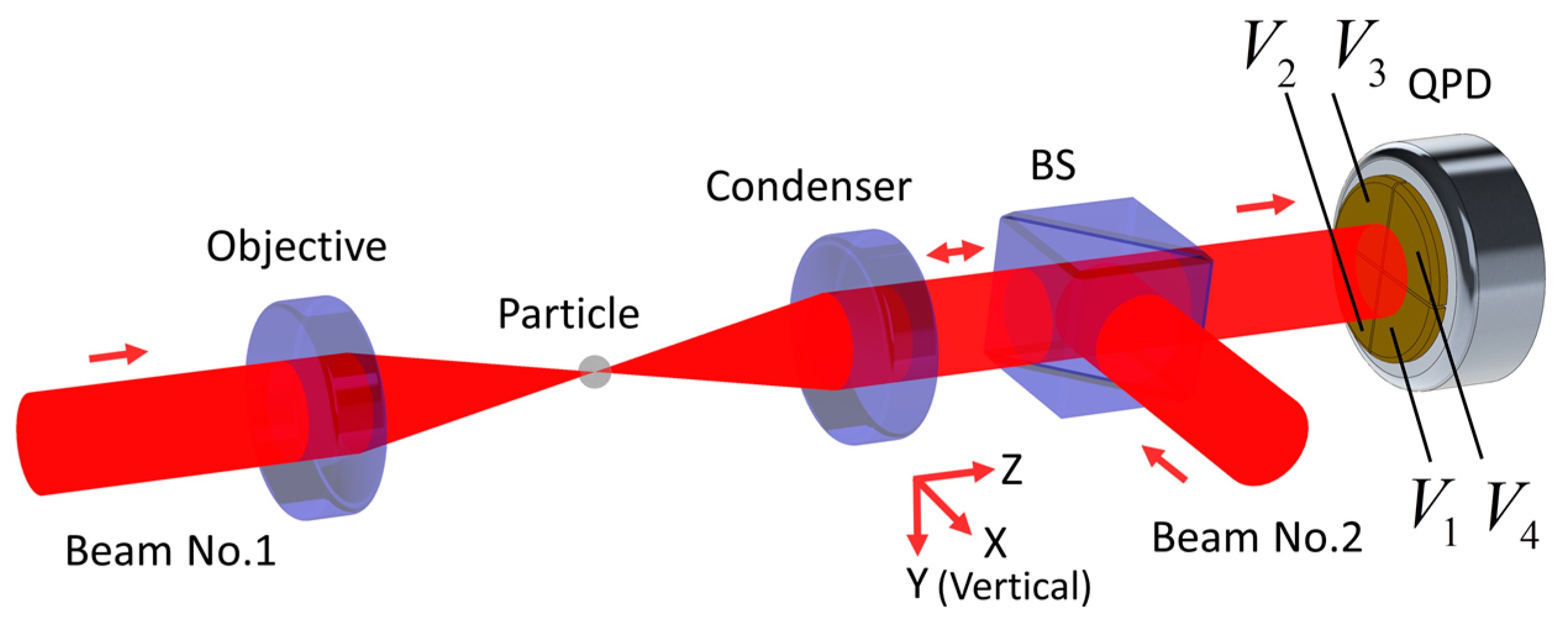Displacement Detection Decoupling in Counter-Propagating Dual-Beams Optical Tweezers with Large-Sized Particle
Abstract
:1. Introduction
2. Theory
Displacement Detection and Coupling
3. Materials and Methods
3.1. Setup in Simulations and Experiments
3.2. Forward Scattered Far Field Computation
3.2.1. Computation Principle
3.2.2. Computation Complexity
3.2.3. Computation Errors
4. Simulations
4.1. Simulation of Computing Forward Scattered Far Field
4.2. Simulation of Decoupling with the Modified QPD Method
5. Experiments
5.1. Experiment of Recording Forward Scattered Far Field
5.2. Experiment of Decoupling with the Modified QPD Method
6. Discussion
7. Conclusions
Supplementary Materials
Author Contributions
Funding
Conflicts of Interest
References
- Choudhary, D.; Mossa, A.; Jadhav, M.; Cecconi, C. Bio-Molecular Applications of Recent Developments in Optical Tweezers. Biomolecules 2019, 9, 23. [Google Scholar] [CrossRef] [PubMed] [Green Version]
- Rider, A.D.; Moore, D.C.; Blakemore, C.P.; Louis, M.; Lu, M.; Gratta, G. Search for Screened Interactions Associated with Dark Energy below the 100 μm Length Scale. Phys. Rev. Lett. 2016, 117, 101101. [Google Scholar] [CrossRef] [PubMed] [Green Version]
- Millen, J.; Deesuwan, T.; Barker, P.; Anders, J. Nanoscale temperature measurements using non-equilibrium Brownian dynamics of a levitated nanosphere. Nat. Nanotechnol. 2014, 9, 425. [Google Scholar] [CrossRef] [PubMed] [Green Version]
- Ashkin, A.; Dziedzic, J.M.; Bjorkholm, J.E.; Chu, S. Observation of a single-beam gradient force optical trap for dielectric particles. Opt. Lett. 1986, 11, 288–290. [Google Scholar] [CrossRef] [PubMed] [Green Version]
- Neuman, K.C.; Block, S.M. Optical trapping. Rev. Sci. Instrum. 2004, 75, 2787. [Google Scholar] [CrossRef] [PubMed]
- Erik, H.; Martin, F.; Rene, R.; Lukas, N. Measuring gravity with optically levitated nanoparticles. Adv. Photonics 2018, 12, 806–810. [Google Scholar] [CrossRef]
- Geraci, A.A.; Smullin, S.J.; Weld, D.M.; Chiaverini, J.; Kapitulnik, A. Improved constraints on non-Newtonian forces at 10 microns. Phys. Rev. D 2008, 78, 022002. [Google Scholar] [CrossRef] [Green Version]
- Ranjit, G.; Atherton, D.P.; Stutz, J.H.; Cunningham, M.; Geraci, A.A. Attonewton force detection using microspheres in a dual-beam optical trap in high vacuum. Phys. Rev. A 2015, 91, 051805. [Google Scholar] [CrossRef] [Green Version]
- Monteiro, F.; Ghosh, S.; Fine, A.G.; Moore, D.C. Optical levitation of 10-ng spheres with nano- g acceleration sensitivity. Phys. Rev. A 2017, 96, 63841. [Google Scholar] [CrossRef] [Green Version]
- Li, W.; Li, N.; Shen, Y.; Fu, Z.; Su, H.; Hu, H. Dynamic analysis and rotation experiment of an optical-trapped microsphere in air. Appl. Opt. 2018, 57, 823–828. [Google Scholar] [CrossRef]
- Taylor, M.A.; Bowen, W.P. A computational tool to characterize particle tracking measurements in optical tweezers. J. Opt. 2013, 15, 85701. [Google Scholar] [CrossRef]
- Li, T.; Kheifets, S.; Raizen, M.G. Millikelvin cooling of an optically trapped microsphere in vacuum. Nat. Phys. 2011, 7, 527–530. [Google Scholar] [CrossRef]
- Ranjit, G.; Cunningham, M.; Casey, K.; Geraci, A.A. Zeptonewton force sensing with nanospheres in an optical lattice. Phys. Rev. A 2016, 93, 053801. [Google Scholar] [CrossRef] [Green Version]
- Gibson, G.; Leach, J.; Keen, S.; Wright, A.; Padgett, M.J. Measuring the accuracy of particle position and force in optical tweezers using high-speed video microscopy. Opt. Express 2008, 16, 14561–14570. [Google Scholar] [CrossRef] [PubMed] [Green Version]
- Khorshad, A.A.; Reihani, S.N.S.; Tavassoly, M.T. Moiré deflectometry-based position detection for optical tweezers. Opt. Lett. 2017, 42, 3506. [Google Scholar] [CrossRef]
- Gittes, F.; Schmidt, C.F. Interference model for back-focal-plane displacement detection in optical tweezers. Opt. Lett. 1998, 23, 7–9. [Google Scholar] [CrossRef]
- Pralle, A.; Prummer, M.; Florin, E.-L.; Stelzer, E.H.; Hörber, J.K. Three-dimensional high-resolution particle tracking for optical tweezers by forward scattered light. Microsc. Res. Tech. 1999, 44, 378–386. [Google Scholar] [CrossRef]
- Rohrbach, A.; Stelzer, E.H. Three-dimensional position detection of optically trapped dielectric particles. J. Appl. Phys. 2002, 91, 5474–5488. [Google Scholar] [CrossRef]
- Nieminen, T.A.; Dunlop, H.R.; Heckenberg, N.R. Multipole expansion of strongly focused laser beams. J. Quant. Spectrosc. Radiat. Transf. 2003, 79, 1005–1017. [Google Scholar] [CrossRef] [Green Version]
- Li, J.C.; Picart, P. Digital Holography; John Wiley & Sons: Hoboken, NJ, USA, 2012. [Google Scholar] [CrossRef]
- Healy, J.J.; Sheridan, J.T. Numerical approximation of scalar diffraction through first order optical systems. Photonics Eur. 2010, 7717, 77171. [Google Scholar] [CrossRef]
- Berg-Sørensen, K.; Flyvbjerg, H. Power spectrum analysis for optical tweezers. Rev. Sci. Instrum. 2004, 75, 594–612. [Google Scholar] [CrossRef] [Green Version]
- Vovrosh, J.; Rashid, M.; Hempston, D.; Bateman, J.; Paternostro, M.; Ulbricht, H. Parametric feedback cooling of levitated optomechanics in a parabolic mirror trap. J. Opt. Soc. Am. B 2017, 34, 1421–1428. [Google Scholar] [CrossRef]








© 2020 by the authors. Licensee MDPI, Basel, Switzerland. This article is an open access article distributed under the terms and conditions of the Creative Commons Attribution (CC BY) license (http://creativecommons.org/licenses/by/4.0/).
Share and Cite
Zhu, X.; Li, N.; Yang, J.; Chen, X.; Hu, H. Displacement Detection Decoupling in Counter-Propagating Dual-Beams Optical Tweezers with Large-Sized Particle. Sensors 2020, 20, 4916. https://doi.org/10.3390/s20174916
Zhu X, Li N, Yang J, Chen X, Hu H. Displacement Detection Decoupling in Counter-Propagating Dual-Beams Optical Tweezers with Large-Sized Particle. Sensors. 2020; 20(17):4916. https://doi.org/10.3390/s20174916
Chicago/Turabian StyleZhu, Xunmin, Nan Li, Jianyu Yang, Xingfan Chen, and Huizhu Hu. 2020. "Displacement Detection Decoupling in Counter-Propagating Dual-Beams Optical Tweezers with Large-Sized Particle" Sensors 20, no. 17: 4916. https://doi.org/10.3390/s20174916
APA StyleZhu, X., Li, N., Yang, J., Chen, X., & Hu, H. (2020). Displacement Detection Decoupling in Counter-Propagating Dual-Beams Optical Tweezers with Large-Sized Particle. Sensors, 20(17), 4916. https://doi.org/10.3390/s20174916







